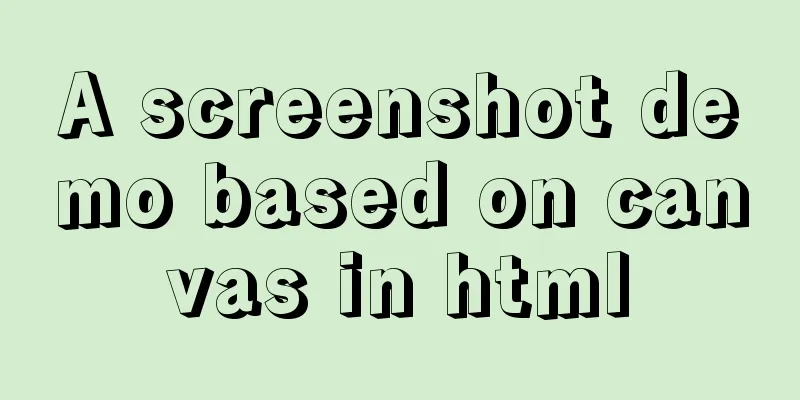Example code for implementing raindrop animation effect with CSS

|
Glass Windows What we are going to achieve today is the raindrop effect. However, before achieving the raindrop effect, we first create the frosted glass effect. Without glass windows, the rain will enter the house, and there will be nothing to knock on.
<div class='window'></div>
.window {
position: absolute;
width: 100vw;
height: 100vh;
background: url("https://cn.bing.com//th?id=OHR.ParrotsIndia_ZH-CN8386276023_UHD.jpg");
background-size: cover;
background-position: 100%;
filter: blur(10px);
}In fact, it is to give a picture a blurred effect, which looks like frosted glass.
A drop of rain The effect of raindrops is very clever. Let's take a look at the complete effect of a drop of rain.
This raindrop is actually divided into two parts. The first part is the shadow at the bottom, which is actually a border. The code is as follows:
.border {
position: absolute;
margin-left: 92px;
margin-top: 51px;
border-radius: 100%;
box-shadow: 0 0 0 2px rgba(0, 0, 0, 0.6);
transform: rotateY(0);
width: 20px;
height: 28px;
}
<div class='border'></div>The border is pulled into an ellipse through the width and height attributes and border-radius, and then the shadow is pulled out with box-shadow as the shadow of the water drop. The final effect of the border is as follows:
Then there is the water droplet part
.raindrop {
filter: brightness(1.2);
position: absolute;
margin-left: 90px;
margin-top: 50px;
background-size: 5vw 5vh;
border-radius: 100%;
background-image: url("https://cn.bing.com//th?id=OHR.ParrotsIndia_ZH-CN8386276023_UHD.jpg");
transform: rotate(180deg) rotateY(0);
background-position: 48.1994160428% 54.3259834959%;
width: 24px;
height: 28px;
}
<div class='raindrop'></div>
The effect of a single water drop without shadow is as follows:
Random Raindrops Rain never comes one drop at a time, and it never comes in a regular pattern. In order to make raindrops appear randomly on the glass windows, the css-doodle framework is used. <css-doodle use="var(--rule)"></css-doodle> First create a custom component of css-doodle
--rule: ( :doodle {
@grid: 10x10/ 100%;
overflow: visible;
}Create a 10*10 grid, so that at most 100 drops of rain can appear Use transform:scale to make raindrops randomly larger or smaller
:before {
content: '';
position: absolute;
margin-left: @var(--mleft);
margin-top: @var(--mtopb);
border-radius: 100%;
box-shadow: 0 0 0 @var(--shadow-size) rgba(0, 0, 0, 0.6);
transform: rotateY(0);
width: @var(--widthb);
height: @var(--height);
}
:after {
content: '';
filter: brightness(1.2);
position: absolute;
margin-left: @var(--mleft);
margin-top: @var(--mtopa);
background-size: 5vw 5vh;
border-radius: 100%;
background-image: url("https://cn.bing.com//th?id=OHR.ParrotsIndia_ZH-CN8386276023_UHD.jpg");
transform: rotate(180deg) rotateY(0);
background-position: @r(1%, 100%) @r(1%, 100%);
width: @var(--widtha);
height: @var(--height);
}Do the :before and :after here look familiar to you? In fact, the content in :before is the style of the previous border, and the content in :after is the style of the previous raindrop. content is required, because if the "content" attribute is not set in the pseudo-element (before, after), the pseudo-element is useless, and the entire configuration in :before and :after will be invalid. In order to make the raindrops appear clearer, filter: brightness(1.2) is added to make the raindrops appear brighter. The strange thing here is @var(), which is actually a CSS variable. It is wrapped in css-doodle and has the same function as CSS's var(). Let's look at the definitions of these variables. --size:(4 + @r(1, 8)); --shadow-size: calc(((@var(--size)*0.3) - 1)*1px); --mleft:@r(1, 100)px; --mtop:@r(1, 100); --mtop1:(@var(--mtop) - 1); --mtopb:calc(@var(--mtop)*1px); --mtopa:calc(@var(--mtop1)*1px); --height:@r(15, 25)px; --width:@r(8, 20); --width1:(@var(--width) + 5); --widthb:calc(@var(--width)*1px); --widtha:calc(@var(--width1)*1px); Here are a few pitfalls to explain: Pitfall No. 1: css-doodle provides @calc(), but the calculation here still needs to use CSS's calc(), and using @calc() is invalid. The final effect is as follows:
How can I knock on my window without animation? If the raindrops just fell on the window, there would be no sense of knocking. In order to reflect the knocking, I decided to make the raindrops move.
:before {
content: '';
position: absolute;
margin-left: @var(--mleft);
margin-top: @var(--mtopb);
border-radius: 100%;
box-shadow: 0 0 0 @var(--shadow-size) rgba(0, 0, 0, 0.6);
transform: rotateY(0);
width: @var(--widthb);
height: @var(--height);
opacity: 0;
animation: raindrop-fall 500ms cubic-bezier(0.175, 0.885, 0.32, 1.275);
animation-fill-mode: forwards;
animation-delay: @var(--delay);
}
:after {
content: '';
filter: brightness(1.2);
position: absolute;
margin-left: @var(--mleft);
margin-top: @var(--mtopa);
background-size: 5vw 5vh;
border-radius: 100%;
background-image: url("https://cn.bing.com//th?id=OHR.ParrotsIndia_ZH-CN8386276023_UHD.jpg");
transform: rotate(180deg) rotateY(0);
background-position: @r(1%, 100%) @r(1%, 100%);
width: @var(--widtha);
height: @var(--height);
opacity: 0;
animation: raindrop-fall 500ms cubic-bezier(0.175, 0.885, 0.32, 1.275);
animation-fill-mode: forwards;
animation-delay: @var(--delay);
}The key point is that the last three lines in :before and :after are used to achieve the animation effect. cubic-bezier() controls the speed of the animation, making the effect of raindrops falling on the glass window more realistic. animation-delay The time when the raindrops appear is random, which is also for the purpose of making the effect more realistic. Realistic effects are really troublesome. Let's take a look at the @keyframe settings of raindrop-fall
@keyframes raindrop-fall {
0% {
opacity: 0;
transform: rotate(180deg) scale(2.5, 2.3) rotateY(0);
}
100% {
opacity: 1;
transform: rotate(180deg) scale(1, 1) rotateY(0);
}
}
Summarize The above is the example code for using CSS to achieve raindrop animation effects that I introduced to you. I hope it will be helpful to you. If you have any questions, please leave me a message and I will reply to you in time. I would also like to thank everyone for their support of the 123WORDPRESS.COM website! |
<<: How to monitor oracle database using zabbix agent2
>>: A brief introduction to JavaScript arrays
Recommend
Vue implements page caching function
This article example shares the specific code of ...
A practical record of restoring a MySQL Slave library
Description of the situation: Today, I logged int...
Installing Windows Server 2008 operating system on a virtual machine
This article introduces the installation of Windo...
MySQL database account creation, authorization, data export and import operation examples
This article describes the examples of creating a...
Detailed tutorial on docker-compose deployment and configuration of Jenkins
Docker-compose deployment configuration jenkins 1...
Solution to the problem of not being able to access the home page when adding a tomcat container to Docker
question The tomcat container was successfully ad...
How to create, start, and stop a Docker container
1. A container is an independently running applic...
Explanation of CAST and CONVERT functions for type conversion in MySQL database
MySQL's CAST() and CONVERT() functions can be...
Summary of the process and common problems of connecting VS2019 to MySQL database
I started configuring various environments this a...
MySQL Community Server 8.0.12 installation and configuration method graphic tutorial
MySQL 8 brings a brand new experience, such as su...
Summary of twelve methods of Vue value transfer
Table of contents 1. From father to son 2. Son to...
How to use js to communicate between two html windows
Scenario: When page A opens page B, after operati...
Implementing a simple carousel based on JavaScript
This article shares the specific code of JavaScri...
Detailed explanation of vue-router 4 usage examples
Table of contents 1. Install and create an instan...
Ubuntu builds Mysql+Keepalived high availability implementation (dual-active hot standby)
Mysql5.5 dual machine hot standby Implementation ...














